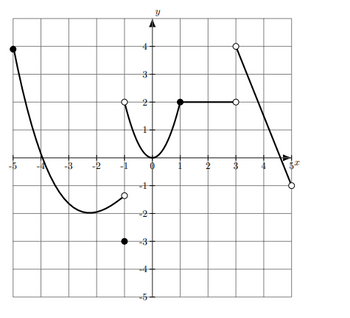
Calculus: Early Transcendentals
8th Edition
ISBN: 9781285741550
Author: James Stewart
Publisher: Cengage Learning
expand_more
expand_more
format_list_bulleted
Question
) Find f(−5), f(−1), f(0), f(1), f(3), and f(5) for y = f(x)

Transcribed Image Text:**Graph Analysis**
The provided graph features a Cartesian coordinate system with both \(x\)- and \(y\)-axes ranging from \(-5\) to \(5\). The axes intersect at the origin (0,0). The graph includes a curve and several notable data points plotted along this curve.
### Key Graph Features:
1. **Curve Behavior**:
- The curve starts at the point \((-5, 4)\).
- It dips down to a local minimum at \((-4, -1.5)\).
- It then rises to a local maximum at \((-1, 2)\).
- After reaching this peak, the curve dips again to a value of \( (0, 0)\).
- The curve rises again, reaching a point at \( (2, 2)\).
- The curve then decreases steadily to a point at \( (3, 2)\).
- Finally, the curve sharply drops to the point \((5,0)\).
2. **Data Points**:
- Solid black filled: These points occur at \((-5, 4)\), \((-4, -1.5)\), \((0, -3)\).
- Unfilled (White): These points occur at \((-1, 2)\), \((1, 1)\), \((2, 2)\), \((3, 2)\), \((4, 4)\) and `5,
### Points of Interest:
- \((-5,4)\)
- \((-4,-1.5)\)
- \((-1, 2)\) (Open point)
- \((0,0)\)
- \((2,2)\) (Open point)
- \((3,2)\) (Open point)
- \((5,0)\) (Solid point)
### Observations:
1. The graph displays both filled and unfilled points (indicating inclusive and exclusive bounds, respectively).
2. The curve has multiple peaks and troughs, indicating the graph includes local maxima and minima throughout the interval from \(-5\) to \(5\).
This type of graph is typically used in calculus to illustrate concepts of continuity, limits, and extremum points. It is important to note these characteristics when analyzing the curve to understand its overall behavior and implications in the function it represents.
Expert Solution
This question has been solved!
Explore an expertly crafted, step-by-step solution for a thorough understanding of key concepts.
Step by stepSolved in 2 steps with 1 images

Knowledge Booster
Similar questions
Recommended textbooks for you
 Calculus: Early TranscendentalsCalculusISBN:9781285741550Author:James StewartPublisher:Cengage Learning
Calculus: Early TranscendentalsCalculusISBN:9781285741550Author:James StewartPublisher:Cengage Learning Thomas' Calculus (14th Edition)CalculusISBN:9780134438986Author:Joel R. Hass, Christopher E. Heil, Maurice D. WeirPublisher:PEARSON
Thomas' Calculus (14th Edition)CalculusISBN:9780134438986Author:Joel R. Hass, Christopher E. Heil, Maurice D. WeirPublisher:PEARSON Calculus: Early Transcendentals (3rd Edition)CalculusISBN:9780134763644Author:William L. Briggs, Lyle Cochran, Bernard Gillett, Eric SchulzPublisher:PEARSON
Calculus: Early Transcendentals (3rd Edition)CalculusISBN:9780134763644Author:William L. Briggs, Lyle Cochran, Bernard Gillett, Eric SchulzPublisher:PEARSON Calculus: Early TranscendentalsCalculusISBN:9781319050740Author:Jon Rogawski, Colin Adams, Robert FranzosaPublisher:W. H. Freeman
Calculus: Early TranscendentalsCalculusISBN:9781319050740Author:Jon Rogawski, Colin Adams, Robert FranzosaPublisher:W. H. Freeman
 Calculus: Early Transcendental FunctionsCalculusISBN:9781337552516Author:Ron Larson, Bruce H. EdwardsPublisher:Cengage Learning
Calculus: Early Transcendental FunctionsCalculusISBN:9781337552516Author:Ron Larson, Bruce H. EdwardsPublisher:Cengage Learning

Calculus: Early Transcendentals
Calculus
ISBN:9781285741550
Author:James Stewart
Publisher:Cengage Learning

Thomas' Calculus (14th Edition)
Calculus
ISBN:9780134438986
Author:Joel R. Hass, Christopher E. Heil, Maurice D. Weir
Publisher:PEARSON

Calculus: Early Transcendentals (3rd Edition)
Calculus
ISBN:9780134763644
Author:William L. Briggs, Lyle Cochran, Bernard Gillett, Eric Schulz
Publisher:PEARSON

Calculus: Early Transcendentals
Calculus
ISBN:9781319050740
Author:Jon Rogawski, Colin Adams, Robert Franzosa
Publisher:W. H. Freeman


Calculus: Early Transcendental Functions
Calculus
ISBN:9781337552516
Author:Ron Larson, Bruce H. Edwards
Publisher:Cengage Learning